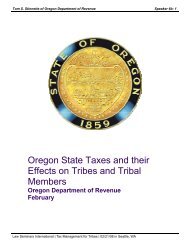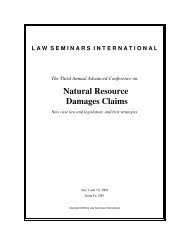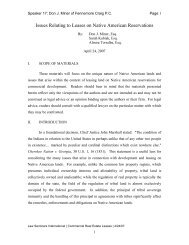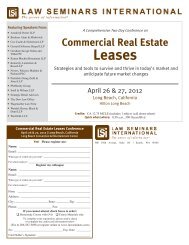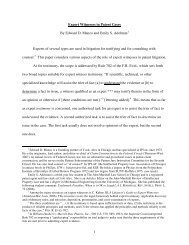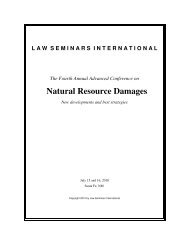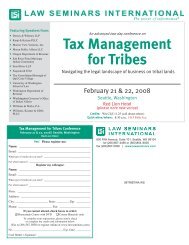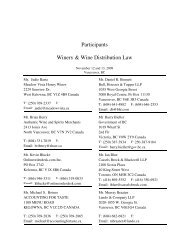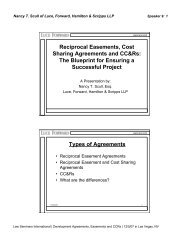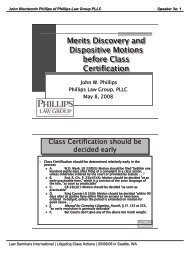LSI 2010 Real Estate Joint Ventures conference materials.pdf
LSI 2010 Real Estate Joint Ventures conference materials.pdf
LSI 2010 Real Estate Joint Ventures conference materials.pdf
Create successful ePaper yourself
Turn your PDF publications into a flip-book with our unique Google optimized e-Paper software.
John W. Hanley, Jr. of Davis Wright Tremaine LLP Speaker 20a: 7<br />
It is not unusual for a prospective lead investor in a new fund, who is prepared to make<br />
an early and disproportionately large capital commitment, to ask for a share of the fund<br />
manager’s promoted interest, as the reward for this investor’s lead commitment to the fund (a<br />
form of early market validation). This sharing of the sponsor’s promoted interest may be<br />
addressed expressly in the fund documents, or it may be covered in a side letter between the fund<br />
manager and the lead investor, making the sharing relatively invisible to later investors. The<br />
effect of sharing the promoted interest will be to diminish the overall return to the fund’s<br />
sponsor. The possibility of extra benefits flowing to an early fund investor, by means of a side<br />
letter agreement, may prompt later investors to ask for a “most favored nations” clause in their<br />
subscription agreements.<br />
In the case of a fund designed for multiple assets, an important question is whether net<br />
cash flow and net capital proceeds from each asset will be tracked and distributed (according to<br />
the waterfall) separately, or whether all proceeds from all assets will be considered fungible,<br />
pooled, and distributed periodically over time on an aggregate and cumulative basis. Under the<br />
former approach, the fund sponsor may begin to receive distributions on account of its promoted<br />
interest quite early in the life of the venture, perhaps even when the first capital transaction<br />
occurs if the harvested asset has been exceptionally profitable. Under the latter approach, the<br />
third tier of distributions is not reached until much later in the life of the fund, even if the fund is<br />
quite successful.<br />
In the case of a fund with multiple assets, if the manager’s promoted interest return is to<br />
be calculated on a cumulative basis, the investors must protect themselves against the possibility<br />
that the most profitable assets will be harvested first. The result of that scenario might be the<br />
fund manager will receive one or more “third tier” distributions in recognition of his promoted<br />
interest in the sold assets, and the fund’s less profitable (or unprofitable) assets will not be sold<br />
until the end of the fund’s life. The effect of that sequence may be that, on a cumulative basis,<br />
the fund manager received a greater distribution that he is strictly entitled to collect, because of<br />
the early year promote-level distributions based only on the most profitable assets. The<br />
customary protection against this form of abuse is the clawback provision, an explicit promise by<br />
the fund manager to return to the fund (for distribution to the investors) the amount of excess<br />
distribution to him. There are many significant details to be addressed in an effective clawback<br />
provision, including the time period during which the investors may trigger the provision<br />
following liquidation of the fund, the mechanics for using it, the actual scope of the clawback<br />
obligation (e.g., whether it calculates the clawed-back amount on a before-tax or after tax basis),<br />
and the credit strength standing behind the obligation.<br />
The importance of the promoted interest as an element of the economics of a real estate<br />
fund (and a driver of the incentives of the manager) cannot be overstated. Under current federal<br />
tax laws, if appropriately structured and documented, promoted interest distributions will be<br />
taxable to the manager only as capital gains, even though arguably earned in consideration of the<br />
services rendered by the fund manager. As this paper is being written, the taxation of promoted<br />
DWT 13620946v1 0000099-071219<br />
Law Seminars International | <strong>Real</strong> <strong>Estate</strong> <strong>Joint</strong> <strong>Ventures</strong> and Funds | 02/09/10 in Seattle, WA<br />
6




